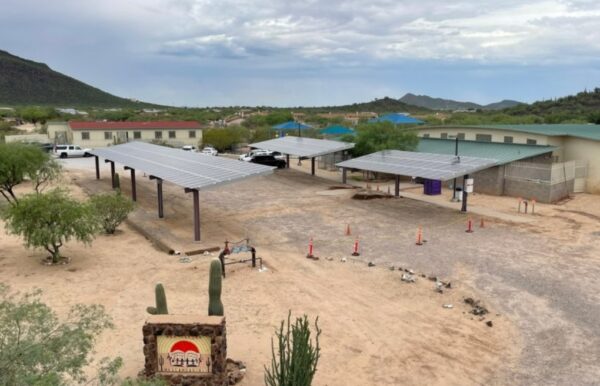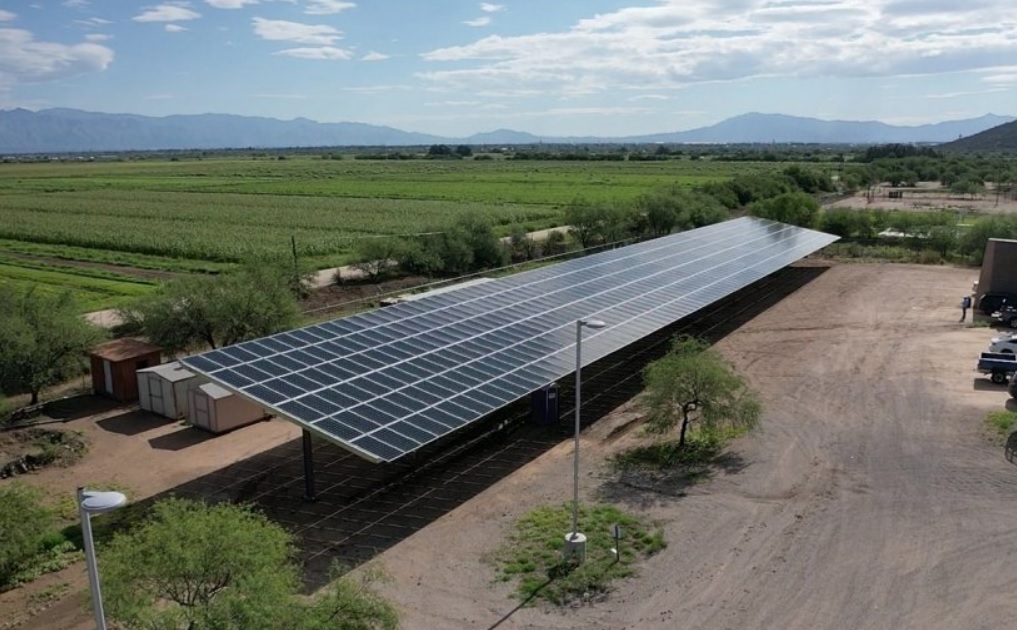A solar installation in the San Xavier District of the Tohono O’odham Nation in Arizona was sorely needed to reduce energy costs, but the benefits are far exceeding cost savings alone. One of 11 districts that comprise the Tohono O’odham Nation, the San Xavier District, sits on nearly 72,000 acres of Sonoran Desert near Tucson, Arizona. The District accounts for 7% of the Tohono O’odham Nation’s population, currently about 2,300 individuals, of which only approximately 1,200 reside within the District’s jurisdiction.
Reducing the tribe’s carbon footprint was the initial impetus behind the project, but they also wanted to reduce their energy costs. With high electric rates and plenty of sunshine in the area of Tucson, Arizona, solar was a preferred solution. Furthermore, they saw it as a way to educate the community on the importance of renewable energy.
The project, which cost about $870,000 and was co-funded by the U.S. Department of Energy Office of Indian Energy, generates 440,000 kWh per year, or enough to power approximately 41 average homes for one year. The cost savings to the Tribe is estimated to be $2,570,000 over the 25-year life of the system.
“Our savings are incredible. It’s literally saving thousands of dollars a month on our bill,” said Sandi Alvarez, director of administration, San Xavier District of the Tohono O’odham Nation. Alvarez said the district has been able to turn the cost savings into additional funding for social programs such as education tuition, housing, repairs, and elderly programs.
The grid-tied carport solar installations serve two buildings: the district administration building and education center. The systems are using Trina Solar frameless bifacial 360 W modules and Canadian Solar inverters. The 182 kW system for the administration building produces 310,000 kWh per year and displaces about 80% of the energy use of the building.

The 73.5 kW system for the education center produces roughly 130,000 kWh per year and displaces about 95% of the building’s energy use. The anticipated 25-year cost savings from the 255 kW systems are estimated to be approximately $1,750,000 and $820,000 for the administration building and the education center, respectively.
This is not the first solar installation for the District. The first one was a 60 kW array installed in 2013 to reduce utility costs and dependence on commercial power. In 2019, a 100 kW facility was constructed for the District’s senior services center and the maintenance building. The success of these two projects was motivation to do more.
The project was competitively selected under the U.S. Department of Energy Office of Indian Energy’s Fiscal Year 2019 funding opportunity announcement “Energy Infrastructure Deployment on Tribal Lands – 2020.
The U.S. Department of Energy (DOE) recently announced $34 million in funding to advance clean energy technology in 18 American Indian and Alaska Native communities. This funding will enable more tribal communities to cut costs, build resilience and self-sufficiency, while also bringing the U.S. closer to the Biden-Harris Administration’s goal of enhancing tribal energy sovereignty and reducing energy costs for all Americans.
This content is protected by copyright and may not be reused. If you want to cooperate with us and would like to reuse some of our content, please contact: editors@pv-magazine.com.









Living in Tucson, I’ve witnessed firsthand the increasing number of solar installations throughout the city. The commitment of both residents and local businesses to embrace clean, renewable energy sources is truly commendable. With abundant sunshine all year round, Tucson possesses the ideal environment for solar energy generation, and it’s heartening to see our community taking full advantage of this valuable resource.
I wanted to take this opportunity to introduce myself and share my own blog, which focuses on promoting sustainable practices and the benefits of solar energy in Tucson. I would be thrilled to collaborate with you on future content, exchange ideas, or contribute a guest post that complements the vision of your blog.
Thank you once again for shedding light on the significant strides Tucson is taking towards a greener, more sustainable future. Together, we can inspire others to embrace solar energy and create a positive impact on our environment and community.
https://www.sunpowerbynova.com/post/harnessing-solar-energy-in-tucson-revolutionizing-sustainability-and-grid-systems